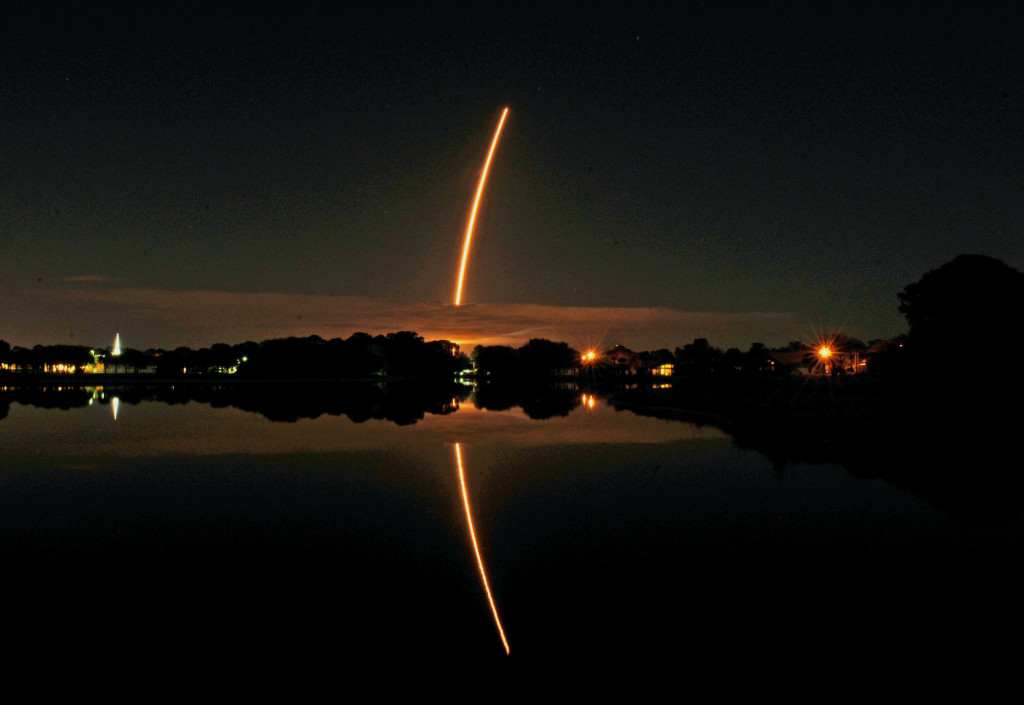Space station cargo launches by light of nearly full moon

An Orbital ATK’s Cygnus space craft atop a United Launch Alliance Atlas V rocket launchs from Cape Canaveral Air Force Station to go to the International Space Station as seen from Viera in Brevard County, Fla., Tuesday, March 22, 2016. Tim Shortt/Florida Today via AP
CAPE CANAVERAL, Florida — Fresh supplies shipped out late Tuesday for the International Space Station, where the shelves finally are getting full after a string of failed deliveries.
Launching beneath the light of a nearly full moon, the unmanned Atlas V rocket provided late-night sparkle as it headed north with its precious cargo and paralleled the East Coast on its way to orbit.
Orbital ATK’s Cygnus capsule holds nearly 8,000 pounds of food, equipment and scientific research for NASA, including a commercial-quality 3-D printer anyone can rent and experimental robotic grippers modeled after the thousands of sticky hairs on geckos’ feet. As usual, some surprises were tucked away for the six space station astronauts, who should receive the delivery Saturday.
READ: 1st PH-made satellite ‘Diwata’ begins journey into space
“Maybe they’ll find a few Easter eggs on board, who knows?” Frank Culbertson, Orbital ATK’s space systems president, said with a smile early Wednesday. He said he didn’t want to give away too much, in case the crew got wind of it.
There’s also a fire experiment that will remain on the Cygnus.
Researchers will ignite a large-scale blaze, in a contained box, to see how it spreads in weightlessness. The fire will not be set until the Cygnus departs the space station in May, full of trash for a destructive re-entry.
Named after the swan constellation, the Cygnus is one of two commercial vehicles used to stock the 250-mile-high space station. Both haulers have lost shipments to rocket failures over the past 1½ years and are still working to catch up. A Russian shipment also ended up destroyed.
Orbital ATK has been using another company’s Atlas rockets to keep the station supplies flowing in the wake of its October 2014 launch explosion at Wallops Island, Virginia. This is the second Cygnus assigned to an Atlas; the first flew from Cape Canaveral Air Force Station in December. The company hopes to resume supply runs from Wallops this summer with its own Antares rockets.
SpaceX, meanwhile, is aiming for an April 8 launch of its Dragon cargo carrier; the last one was destroyed in a June launch accident. It will be the first time both a Cygnus and Dragon are at the orbiting outpost at the same time.
Orbital ATK named this capsule after the late Rick Husband, commander of the doomed space shuttle Columbia. He piloted the first shuttle docking at the International Space Station, in 1999. His widow and two children were on hand for the launch.
“Godspeed SS Rick D Husband!” astronaut Terry Virts said in a tweet from NASA’s Mission Control in Houston.
NASA contracted out space station cargo deliveries — and beginning as early as next year, crew taxi flights — to concentrate on getting humans to Mars in the 2030s. Earlier this month, U.S. astronaut Scott Kelly returned from a yearlong stay at the station, helping to push that goal forward.